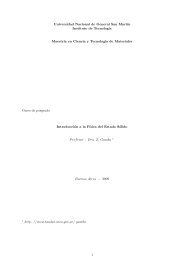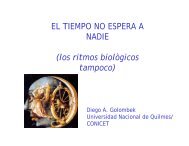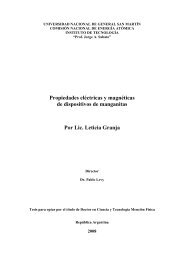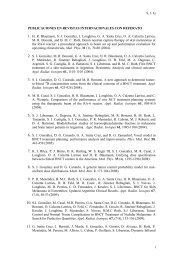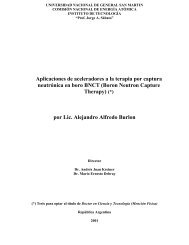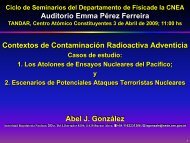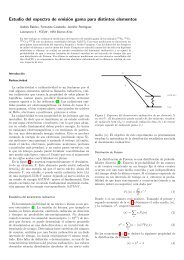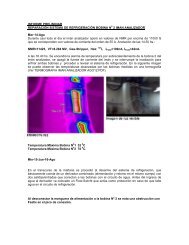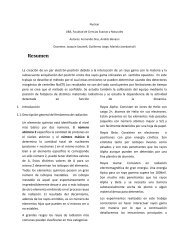Familia de Mapas del Panadero Como Ambiente Caótico de la ...
Familia de Mapas del Panadero Como Ambiente Caótico de la ...
Familia de Mapas del Panadero Como Ambiente Caótico de la ...
You also want an ePaper? Increase the reach of your titles
YUMPU automatically turns print PDFs into web optimized ePapers that Google loves.
CAPÍTULO 5. CAMINATA ACOPLADA A PANADERO 69<br />
5.7.1. Distancia Entre Wigners<br />
Una medida <strong>de</strong> cuánto difieren <strong>la</strong> evolución <strong>de</strong>l caminante acop<strong>la</strong>do con el pana<strong>de</strong>ro y con<br />
el <strong>de</strong> <strong>de</strong>coherencia total, es <strong>la</strong> distancia entre sus funciones <strong>de</strong> Wigners.<br />
Utilizaremos como distancia entre Wigners a <strong>la</strong> suma <strong>de</strong> los cuadrados <strong>de</strong> <strong>la</strong>s diferencias <strong>de</strong><br />
<strong>la</strong>s Wigners.<br />
Al utilizar <strong>la</strong> segunda propiedad <strong>de</strong> <strong>la</strong>s funciones <strong>de</strong> Wigner, esta distancia se pue<strong>de</strong> escribir<br />
como:<br />
δ<strong>de</strong>co ≡ <br />
(W (q, p) − W (q, p)<strong>de</strong>co)<br />
q, p<br />
2 ∝ T r[(ρ − ρ<strong>de</strong>co) 2 ] (5.25)<br />
En <strong>la</strong> figura 5.19 se muestra δ<strong>de</strong>co en función <strong>de</strong>l tiempo para <strong>la</strong> familia <strong>de</strong>l pana<strong>de</strong>ro <strong>de</strong> 7<br />
qubits. Nuevamente se observa que el mapa <strong>de</strong> varias monedas es el más alejado <strong>de</strong> <strong>la</strong> caminata<br />
clásica. Se pue<strong>de</strong> notar que <strong>de</strong>ntro <strong>de</strong>l resto <strong>de</strong> los miembros <strong>de</strong>l pana<strong>de</strong>ro los que menos distan<br />
<strong>de</strong> <strong>la</strong> caminata clásica son los miembros intermedios y no el pana<strong>de</strong>ro convencional.<br />
δ <strong>de</strong>co<br />
0.24<br />
0.22<br />
0.20<br />
0.18<br />
0.16<br />
0.14<br />
0.12<br />
0.10<br />
0.08<br />
0.06<br />
0.04<br />
0.02<br />
fam 1 (Baker)<br />
fam 2<br />
fam 3<br />
fam 4<br />
fam 5<br />
fam 6<br />
fam 7 (Many Coins)<br />
0.00<br />
0 20 40 60 80 100 120 140<br />
t<br />
160 180 200 220 240<br />
δ <strong>de</strong>co<br />
0.25<br />
0.125<br />
0.0625<br />
0.03125<br />
fam 1 (Baker)<br />
fam 2<br />
fam 3<br />
fam 4<br />
fam 5<br />
fam 6<br />
fam 7 (Many Coins)<br />
8 16 32 64 128 256<br />
t<br />
Figura 5.19: Distancia <strong>de</strong> Wigner con <strong>la</strong> <strong>de</strong> <strong>de</strong>coherencia total para <strong>la</strong> familia <strong>de</strong>l pana<strong>de</strong>ro con condiciones<br />
periódicas <strong>de</strong> 7 qubits con condiciones iniciales “simétrica”. En <strong>la</strong> izquierda se ve en esca<strong>la</strong> lineal<br />
y en <strong>la</strong> <strong>de</strong>recha logarítmica.



